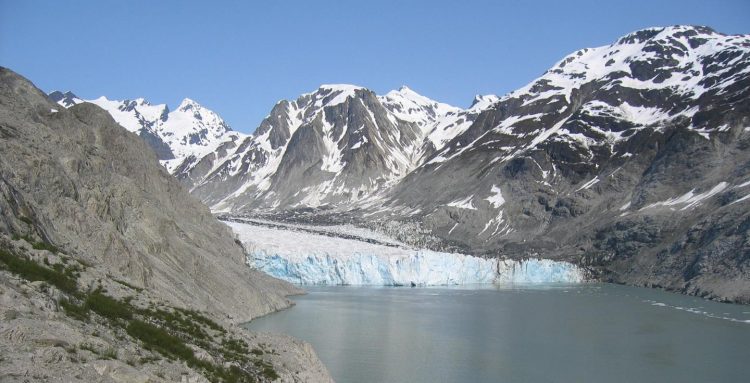Massive amounts of fresh water, glacial melt pouring into Gulf of Alaska

This Alaskan glacier melts directly into the sea. Photo courtesy of Oregon State University
Since it's broken into literally thousands of small drainages pouring off mountains that rise quickly from sea level over a short distance, the totality of this runoff has received less attention, scientists say. But research that's more precise than ever before is making clear the magnitude and importance of the runoff, which can affect everything from marine life to global sea level.
The collective fresh water discharge of this region is more than four times greater than the mighty Yukon River of Alaska and Canada, and half again as much as the Mississippi River, which drains all or part of 31 states and a land mass more than six times as large.
“Freshwater runoff of this magnitude can influence marine biology, nearshore oceanographic studies of temperature and salinity, ocean currents, sea level and other issues,” said David Hill, lead author of the research and an associate professor in the College of Engineering at Oregon State University.
“This is an area of considerable interest, with its many retreating glaciers,” Hill added, “and with this data as a baseline we'll now be able to better monitor how it changes in the future.”
The findings were reported in the Journal of Geophysical Research: Oceans, by Hill and Anthony Arendt at the University of Alaska-Fairbanks. It was supported by the North Pacific Research Board.
This is one of the first studies to accurately document the amount of water being contributed by melting glaciers, which add about 57 cubic kilometers of water a year to the estimated 792 cubic kilometers produced by annual precipitation in this region. The combination of glacial melt and precipitation produce an amount of water that's larger than many of the world's great rivers, such as the Ganges, Nile, Volga, Niger, Columbia, Danube or Yellow River.
“By combining satellite technology with on-the-ground hydraulic measurements and modeling, we're able to develop much more precise information over a wider area than ever before possible,” Hill said.
The data were acquired as an average of precipitation, glacial melting and runoff over a six-year period, from 2003 to 2009. Knocked down in many places by steep mountains, the extraordinary precipitation that sets the stage for this runoff averages about 6 feet per year for the entire area, Hill said, and more than 30 feet in some areas.
The study does not predict future trends in runoff, Hill said. Global warming is expected in the future, but precipitation predictions are more variable. Glacial melt is also a variable. A warmer climate would at first be expected to speed the retreat of existing glaciers, but the amount of water produced at some point may decrease as the glaciers dwindle or disappear.
Additional precision in this study was provided by NASA's Gravity Recovery and Climate Experiment, or GRACE satellites, which can make detailed measurements of gravity and, as one result, estimate the mass of glaciers they are flying over. As the glacial mass decreases over time, the amount of melted water that was produced can be calculated.
The close agreement of land-based measurements also help confirm the accuracy of those made from space, a point that will be important for better global understanding of water stored in a high-altitude environment.
Some of the processes at work are vividly illustrated at Glacier Bay National Park, where some of the most rapidly retreating glaciers in the world are visited each year by hundreds of thousands of tourists, many on cruise ships.
Media Contact
All latest news from the category: Earth Sciences
Earth Sciences (also referred to as Geosciences), which deals with basic issues surrounding our planet, plays a vital role in the area of energy and raw materials supply.
Earth Sciences comprises subjects such as geology, geography, geological informatics, paleontology, mineralogy, petrography, crystallography, geophysics, geodesy, glaciology, cartography, photogrammetry, meteorology and seismology, early-warning systems, earthquake research and polar research.
Newest articles

NASA: Mystery of life’s handedness deepens
The mystery of why life uses molecules with specific orientations has deepened with a NASA-funded discovery that RNA — a key molecule thought to have potentially held the instructions for…

What are the effects of historic lithium mining on water quality?
Study reveals low levels of common contaminants but high levels of other elements in waters associated with an abandoned lithium mine. Lithium ore and mining waste from a historic lithium…

Quantum-inspired design boosts efficiency of heat-to-electricity conversion
Rice engineers take unconventional route to improving thermophotovoltaic systems. Researchers at Rice University have found a new way to improve a key element of thermophotovoltaic (TPV) systems, which convert heat…



